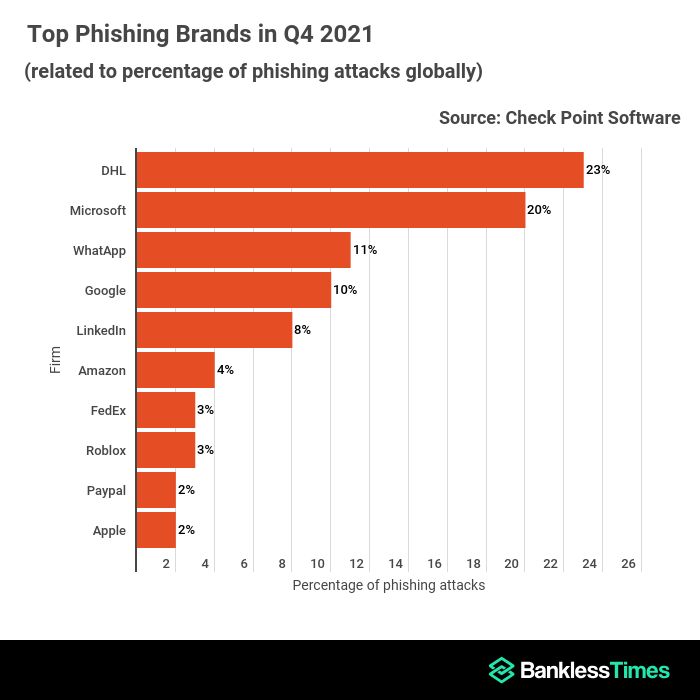- Document Handling Limited (DHL)attracted 23% of Q4 2021 global phishing attempts.
- DHL beat Microsoft to the top spot after the latter experienced decreased attacks.
Thanks to the coronavirus crisis, online retail services are experiencing an uptick in their adoption. That, in turn, has created opportunities for scam activities to thrive. One that’s taken hold at this time is brand Phishing.
Banklesstimes.com has presented findings of the Global Brand Phishing Report for Q4 2021. The study identified firms prone to most hacking attempts for that time. Its findings revealed that phishers had a preference for DHL. Their schemes targeted users’ private and confidential information.

Phishers love DHL
XYZ’s data presentation shows that DHL attracted 23% of all phishing attempts. That figure made it the most alluring to phishers. It represented a 14% increase from Q3 stats earning the firm the unenviable tag. The logistics and shipments firm replaced Microsoft at the index’s helm in doing so.
So what explains DHL’s allure for phishers in Q4 2021? Check Point Software’s Omer Dembinsky links it to an increase in new and vulnerable online customers during the year’s busiest retail period. He holds that many older customers were purchasing online for the first time. Thus they may not have known how to check for delivery confirmation emails or tracking updates.
Falling to the second spot was Microsoft, which had dominated the Q3 rankings. Then it had attracted up to 29% of all the attacks. But the software giant experienced some reprieve in Q4. Its share of phishing attempts declined by 9% to stand at 20%.
Phishing and the social media
Additionally, social platforms remained prime targets for phishing schemes. WhatsApp commanded the third spot in those Q4 rankings after drawing 11% of the pursuits. Also, LinkedIn rose from eighth to fifth place, drawing 8% of all phishing-related attempts. But Facebook dropped from the top 10 brands that appeal to phishers.
Omer attributes that to the opportunistic nature of fraudsters in the cyber scene. They often explore market trends to impersonate prominent companies. This way, phishers may succeed in stealing personal information or deploying malware on a user’s device.
He adds that criminal actors will continue targeting social media for their exploitation. They target online users who, because of working remotely and the COVID-19’s effects, rely on social media channels.
How do they do it?
Phishers strive to replicate legitimate websites of prominent brands. They do so by employing domain names or URLs which mimic the actual sites. Moreover, they can design their web pages to resemble legitimate ones.
Attackers can provide bogus web links in several ways. The first one is via emails or texts. Alternatively, the scammers can redirect you while you’re browsing the internet. Moreover, the exploit may come as a malicious app. All these means direct you to a sham site where the bad actors steal your confidential information.
Regrettably, the targeted firms can’t do much to counter such endeavors. Many online users overlook minute suspicious details like typing errors, incorrectly spelled domains, and incorrect dates. Thus they provide scammers the opportunity to execute their con. One needs to exercise caution when transacting online.












